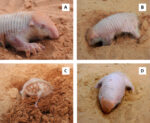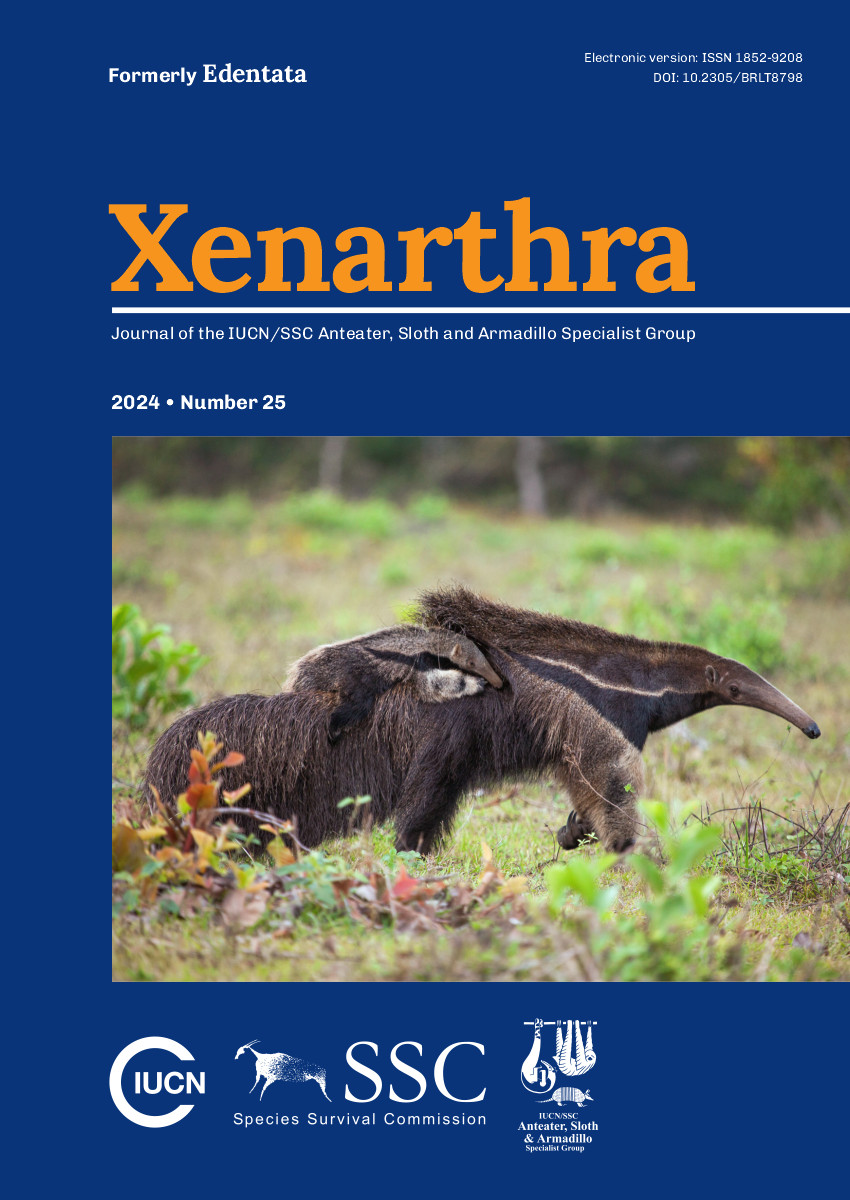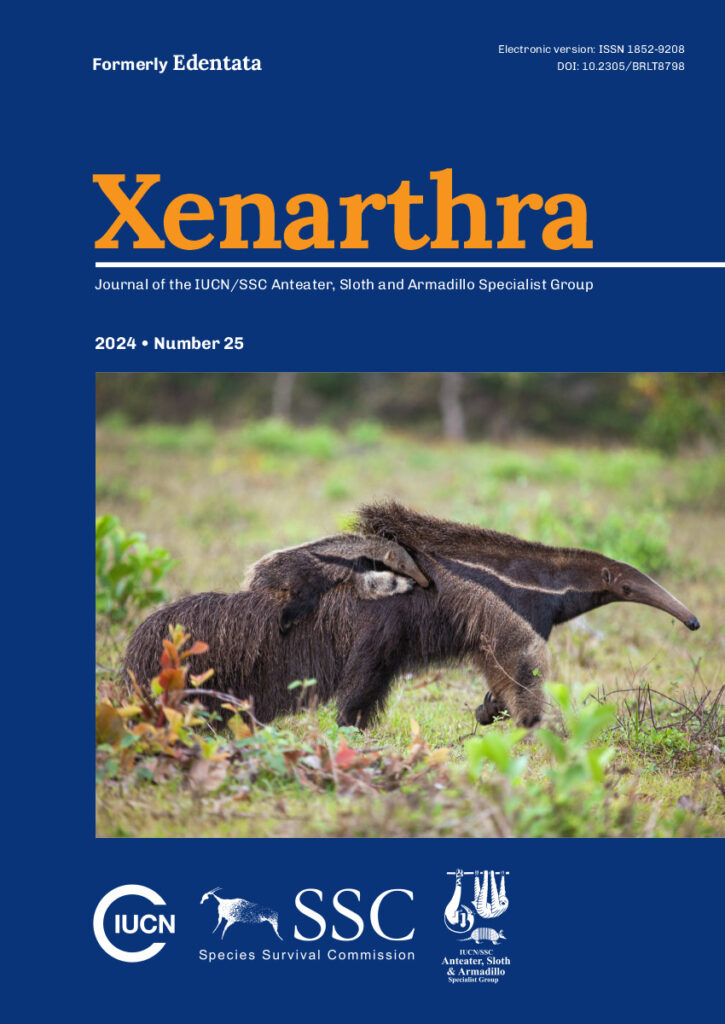December 2024
Contents
| Abstract | Type or Section | OpenGraph image | Title | Authors | DOI | e-Locator | |
|---|---|---|---|---|---|---|---|
The nine-banded armadillo (Dasypus novemcinctus) is a widely distributed species throughout North and South America, however its distribution has been restricted by latitude and altitude due to cold temperatures. The maximum reported altitude for the nine-banded armadillo is between 2000–3000 m asl; hence, new records at high elevations might suggest range shifts. Here we report video evidence of a nine-banded armadillo at 3400 m asl near the summit of the Irazú volcano in Costa Rica, which extends upwards the previously known elevation range by 300 m. We speculate this altitudinal range extension is indicative of regime shifts of ecosystems due to climate variability in response to rising temperatures, such as previously reported for several species. Extensión altitudinal del área de distribución del armadillo de nueve bandas, Dasypus novemcinctus (Linnaeus, 1758) (Mammalia, Xenarthra), en el Parque Nacional Volcán Irazú, Costa Rica. El armadillo de nueve bandas (Dasypus novemcinctus) es una especie ampliamente distribuida por Norteamérica y Sudamérica, aunque su distribución se ha visto restringida por la latitud y la altitud debido a las bajas temperaturas. La altitud máxima registrada del armadillo de nueve bandas es de 2000–3000 msnm, por lo que nuevos registros a grandes altitudes podrían sugerir modificaciones en su rango. Aquí reportamos evidencia en video de un armadillo de nueve bandas a 3400 msnm, cerca de la cima del volcán Irazú en Costa Rica. Este registro extiende el rango de elevación previamente conocido en 300 m. Especulamos que esta extensión del rango altitudinal es indicativa de cambios en el régimen de los ecosistemas debido a la variabilidad climática en respuesta al aumento de las temperaturas, tal como se reportó previamente para varias especies. | Article |  | Altitudinal range extension of the nine-banded armadillo, Dasypus novemcinctus (Linnaeus, 1758) (Mammalia, Xenarthra), in Irazú Volcano National Park, Costa Rica | Kevin J. Lloyd, Carolina Sáenz-Bolaños, Victor H. Montalvo, Brayan Morera, Isabel Hagnauer, Eduardo Carrillo | 10.2305/RUMC9413 | e2501 | |
Two structural abnormalities are reported in southern three-banded armadillos Tolypeutes matacus (Chlamyphoridae) from Paraguay. Additional reports of individuals with amputated legs are noted, and a potential explanation for the frequency of such occurrences associated with predation and their defensive behavior is hypothesized. This is the first documented report of a band anomaly for adults of this species. Anomalías estructurales en tatú bolita Tolypeutes matacus (Chlamyphoridae) de Paraguay. Se reportan dos anomalías estructurales en el tatú bolita Tolypeutes matacus (Chlamyphoridae) de Paraguay. Se reportan casos adicionales de individuos con extremidades amputadas y se plantea la hipótesis de una posible explicación para la frecuencia de tales sucesos asociados con la depredación y su comportamiento defensivo. También se documenta el primer reporte de una anomalía de bandas en adultos de esta especie. | Field Note |  | Structural abnormalities in Paraguayan southern three-banded armadillos Tolypeutes matacus (Chlamyphoridae) | Paul Smith | 10.2305/GQXT2944 | e2502 | |
En los últimos años las observaciones del coseverú (Calyptophractus retusus) en Bolivia han ido en aumento. En esta nota se presentan nueve reportes provenientes principalmente de llamadas por parte de la población ante la presencia de la especie en la ciudad de Santa Cruz de la Sierra y sus alrededores y del encuentro fortuito de los autores con la especie. Además, se presentan los registros de otros tres individuos que provienen de la zona de Isoso, Charagua Iyambae, en comunidades sobre las riberas del río Parapetí. La mayoría de los individuos fueron medidos y luego liberados en sitios seguros. La aparición de estos individuos probablemente se deba al acelerado y desordenado crecimiento de la urbe en el caso de la ciudad y al aumento de actividades agrícolas en la zona del Chaco. New records of Calyptophractus retusus (Cingulata: Chlamyphoridae) in Bolivia. In recent years, observations of the coseverú or greater fairy armadillo (Calyptophractus retusus) in Bolivia have increased. In this note we present nine reports, mainly from calls from the population about the presence of the species in the city of Santa Cruz de la Sierra and its surroundings, and from chance encounters of the authors with the species. In addition, we present the records of three other individuals from the area of Isoso, Charagua Iyambae, in communities on the banks of the Parapetí River. Most of the individuals were measured and then released in safe areas. The appearance of these individuals is probably due to the accelerated and unregulated urban sprawl of the city of Santa Cruz, and the increase of agricultural activities in the Chaco area. | Short Communication |  | Nuevos registros de Calyptophractus retusus (Cingulata: Chlamyphoridae) en Bolivia | Sebastián Gutiérrez-Cruz, Luis A. Galvez, Romer S. Miserendino Salazar, Eliamne K. Gutiérrez-Ojeda | 10.2305/OUMF6063 | e2503 |



